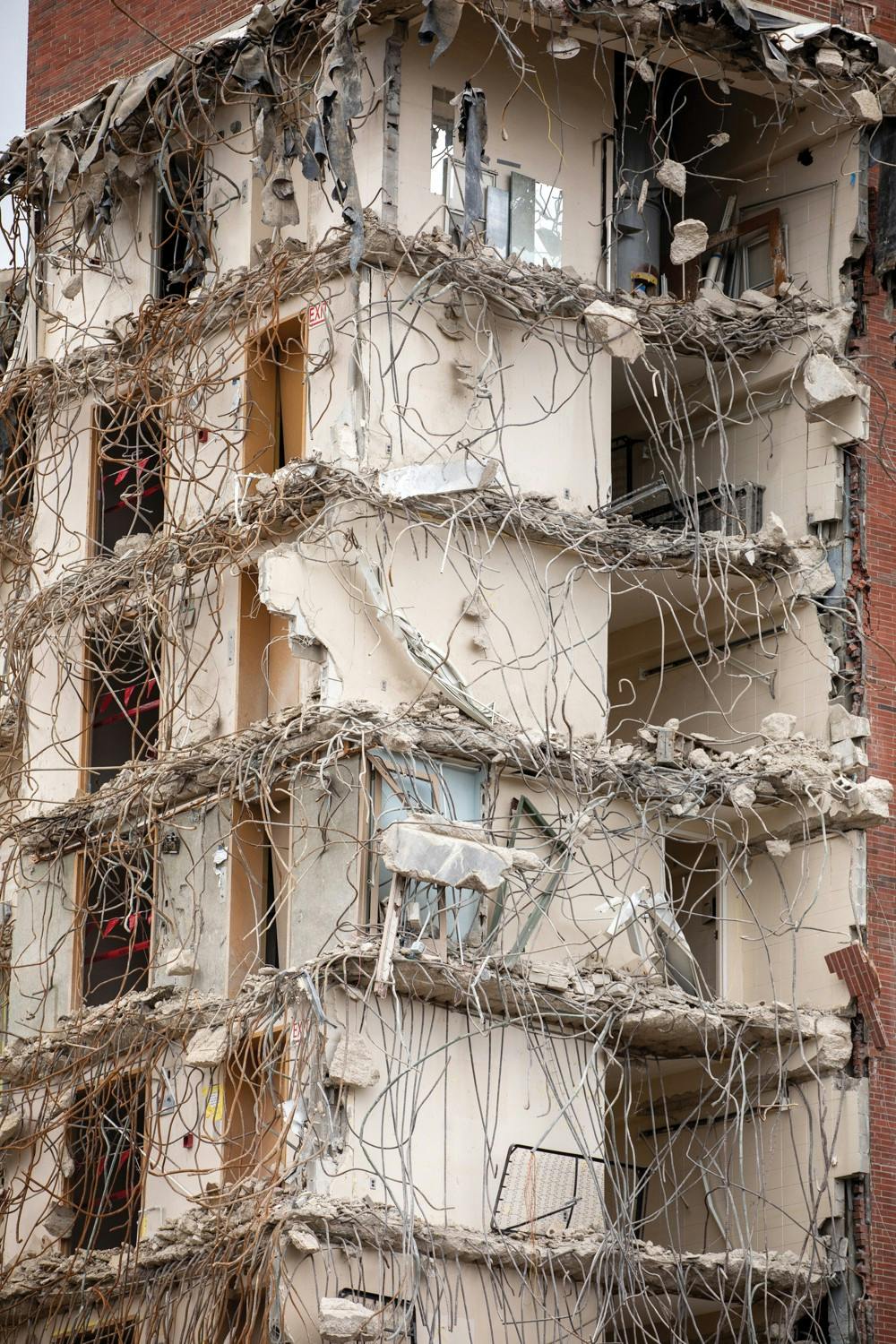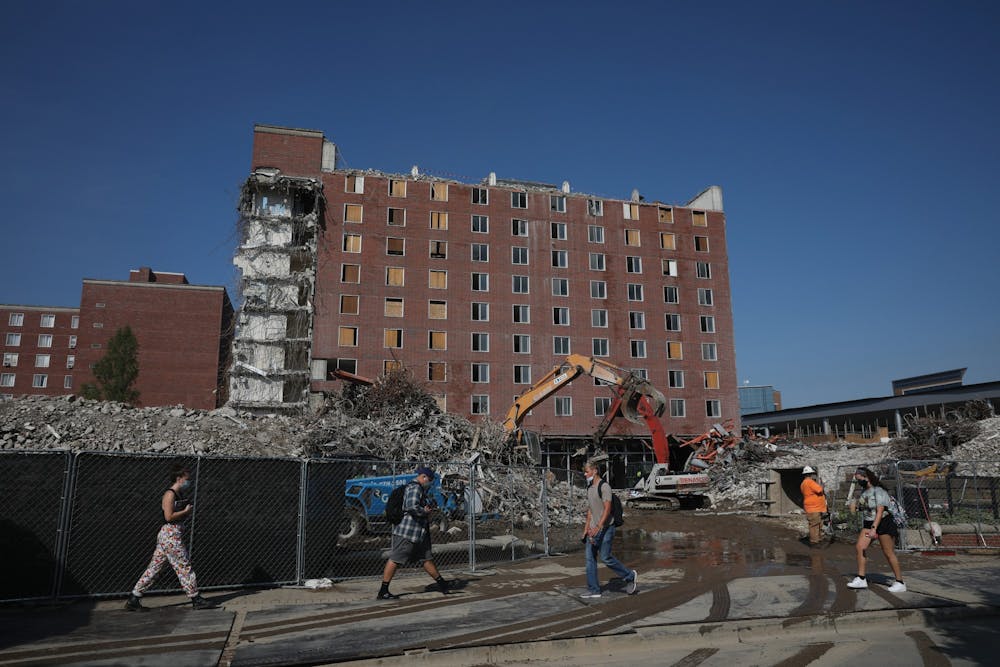“Mammoth.”
That’s how James Lowe, the associate vice president for facilities planning and management at Ball State University, described the LaFollette Complex that once stood in full.
One of the oldest residence halls on Ball State’s campus. Gone.
The ability to fit 1,900 beds in one complex. Gone.
A seating area commemorating the structure that once stood, a green space for students and additional seating for North Dining. Coming soon.
“We decided that LaFollette Hall, as we look forward, was one of those facilities that [was] not economically feasible to keep,” Lowe said. “There were too many other inherent reasons why it would be very expensive. Plus, you may not be aware, but if you look around campus at all our other residence halls, [there] are about 550-600 beds and capacity.”
Lowe’s department covers a wide variety of problems on campus including construction, renovation and maintenance of all academic and administrative buildings. The department provides infrastructure and support architecturally, mechanically and electrically.
The plan to tear down LaFollette began in 2015 and has been in motion since. It started with the building of two new residence halls in the North Neighborhood and the remodeling of Johnson A and B. Along with those renovations, North Dining was also built and part of the plan in motion.
“Once those projects were complete, we could totally take LaFollette down, but we did so in parts,” Lowe said. “As we built out and renovated certain parts of the North residential halls, we did phase demolition of LaFollette. In 2017, we took two halls down, and in 2020, we took the biggest portion of LaFollette off and tore that down, including the middle section.”
While they are building a new green space for students, they are also redoing the bike/pedestrian path along the hall.
“We are going to plant trees [and] install a seating area in the middle of the green space where students can just sit, turn on their laptops and enjoy a sunny day,” Lowe said.
Since they are demolishing on an active campus, Lowe describes some of the precautions that have to be taken.
“With any project that any contractor undertakes at Ball State University, we surround it with [a] protective fence to keep people from walking through that area,” Lowe said. “The other thing we have to be aware of …we are still in session. There are trucks that are hauling away debris, there is heavy construction traffic that's coming in, [there are] students walking, students biking, people driving and so forth.”
Due to this, Lowe and others work with construction firms to have pathways on the project site, so they don’t drive throughout campus, he said.
Robert Ramey, director of construction at Ball State, also talked about the challenge of demolishing and building on where LaFollette once stood.
“One of the first things is you go through your schematic and delegated design,” Ramey said. “You look at your phasing [and] staging of a project and just overall use of our University and ask, ‘Alright, so how are we going to utilize this space once you know a structure is removed? What best suits the campus, suits the area, landscaping and etc.?’”

Wires and metal hand out of the half-torn-down side of LaFollette Sept. 9, 2020, on McKinley Avenue. LaFollette being torn down was a part of the University’s 2015 Master Plan to revitalize the university with new buildings. Jacob Musselman, DN
Ramey said they hope to have LaFallotte torn down before the end of 2022, and the demolition will most likely last through the end of the calendar year.
Some past students have great memories about LaFollette Hall, one being alumnus David Studinski, who lived in LaFollette from 2003-04 during his freshman year.
“The ability to have our doors cracked open the entire time, to be able to wander the hallway and just poke into people's rooms and say, ‘Hi’ and to have a very much convenient and community experience,” Studinski said, “... that really made it feel like you had moved into a really special place.”
Alumnus Gerry Appel, who stayed in LaFollette for two academic years, 97’-98 and 98’-99,’ also had his reasons why LaFollette was special to him.
“Because the complex was so large it was such a great opportunity to meet all sorts of people and make a lot of friends,” Appel said. “It was great how there were several food [and] several dining options inside the building. So, on those awful winter days, if you don't have class, you can stay inside but, you know, I think we really kind of made it the most special. This is no offense to anybody, but LaFollette wasn't exactly the nicest residence hall that we’ve seen in this country and that just forced you to make friends and get along with others.”
Appel also credits the residence hall assistants and a strong Residence Hall Association presence in Brayton/Clevenger while he was in school.
One section —Brayton/Clevenger — still stands as the ‘hub’ of LaFollette’s infrastructure. Lowe mentioned the extensive amount of work it would take to cut off the services, which is why it is the last remaining hall of the complex.
Studinski talked about seeing the structure almost completely gone during 2022 homecoming week and how it brought back memories and a period of reflection on everything he experienced while living there. He said even though it had been a long time since he lived there, just seeing it had the ability to bring back memories.
Appel compared himself to “sounding like an old man” when talking about the tearing down of the complex. He talked about how although living in a top-notch facility is nice, living somewhere that maybe is not the nicest forces you to appreciate things and make more friends.
The seating in the new green area will be made out of limestone reused from LaFollette that will memorialize each hall, something Studinski said shows the lasting importance of the complex.
“For them to know that they needed to do something meaningful in what otherwise was not a spectacular building by modern standards, but the fact that time and time again people talk about the experience of what those buildings are,” Studinski said. “The fact that they saw that much power in that experience that they needed to commemorate it on campus, I think that really says a lot for what that building meant to campus.”
Contact Elijah Poe with comments at elijah.poe@bsu.edu or on Twitter @ElijahPoe4.




